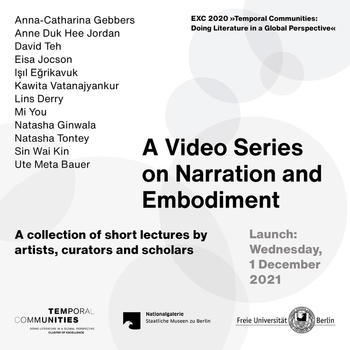Narration and Embodiment – A Video Lecture Series
Narration and Embodiment – A Video Lecture Series brings together twelve short presentations by internationally active artists, scholars, and curators. Anna-Catharina Gebbers, Anne Duk Hee Jordan, David Teh, Eisa Jocson, Işıl Eğrikavuk, Kawita Vatanajyankur, Lins Derry, Mi You, Natasha Ginwala, Natasha Tontey, Sin Wai Kin and Ute Meta Bauer investigate materials, research questions, and provocations that pertain to both historic and contemporary narratives, examining the potential for collection, transmission, and worlding. The videos contribute to the project's broader inquiry into how embodied creative practices, such as performance, can unfold alternative narratives, practices of embodying histories and the transfer of embodied knowledge.
Narration and Embodiment – A Video Lecture Series is part of the research transfer project Circulating Narratives – Entangling Communities: Case Studies in Global Performance Art, which explores how diverse histories inform performative practices and shape communities as embodied knowledge. In collaboration with Hamburger Bahnhof – Museum für Gegenwart – Berlin, the project accompanies the museum's exhibition Nation, Narration, Narcosis: Collecting Entanglements and Embodied Histories, curated by Anna-Catharina Gebbers with Grace Samboh, Gridthiya Gaweewong and June Yap, funded by the Kulturstiftung des Bundes and initiated by the Goethe-Institut, which opened in November 2021 in Berlin. The project primarily focuses on the intersections between Southeast Asian and so-called 'Western' performative practices, while addressing the blind spots in traditional historiography in 'the West', as well as the consequences of colonialism and relationships capable of advancing the deconstruction of the 'Western' canon. Conceiving the global cultural institutions of the future involves addressing the questions of how traces of history – embodied both in actual bodies and in artifacts in museum collections and archives – can be made visible, and how forms of memory can be both preserved and treated respectfully.
Programme: Anna-Catharina Gebbers, Siobhan Leddy, Annette Jael Lehmann, Lieselotte Schinzing
Organisation: Siobhan Leddy & Lieselotte Schinzing
EXC 2020 Temporal Communities, Freie Universität, Berlin
Research Area 2: Travelling Matters
Project: Circulating Narratives – Entangling Communities: Case Studies in Global Performance Art
Project Lead: Prof. Dr. Annette-Jael Lehmann

